Quick Look
Grade Level: 4 (3-5)
Time Required: 45 minutes
Lesson Dependency: None
Subject Areas: Geometry, Physical Science, Problem Solving, Reasoning and Proof, Science and Technology
NGSS Performance Expectations:

| 3-5-ETS1-1 |
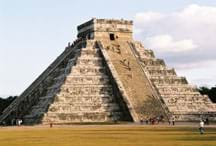
Summary
Students explore methods employing simple machines likely used in ancient pyramid building, as well as common modern-day material transportation. They learn about the wheel and axle as a means to transport materials from rock quarry to construction site. They also learn about different types and uses of a lever for purposes of transport. In an open-ended design activity, students choose from everyday materials to engineer a small-scale cart and lever system to convey pyramid-building materials.Engineering Connection
The simple machines explored in this lesson — wheel and axle, and lever — are relevant to modern-day, real-world methods of material transportation. Just as ancient engineers used simple machines in the transportation of stone for pyramid building, today's construction engineers continue to use simple machines to gain mechanical advantage in the transport of large and heavy materials. Think of all the big trucks that are used to transport materials. Some of these trucks have lifts — like garbage trucks — that work like levers to unload materials. Ancient and modern day engineers use the concept of balanced and unbalanced forces to move large and heavy materials.
Learning Objectives
After this lesson, students should be able to:
- Explain the evolution and re-engineered uses of the wheel and axle.
- Explain the evolution and re-engineered uses of a lever.
- Understand how a wheel can be described as a lever.
- Understand the many ways that engineers use the wheel and axle, and lever (as well as other simple machines) on a daily basis.
Educational Standards
Each TeachEngineering lesson or activity is correlated to one or more K-12 science,
technology, engineering or math (STEM) educational standards.
All 100,000+ K-12 STEM standards covered in TeachEngineering are collected, maintained and packaged by the Achievement Standards Network (ASN),
a project of D2L (www.achievementstandards.org).
In the ASN, standards are hierarchically structured: first by source; e.g., by state; within source by type; e.g., science or mathematics;
within type by subtype, then by grade, etc.
Each TeachEngineering lesson or activity is correlated to one or more K-12 science, technology, engineering or math (STEM) educational standards.
All 100,000+ K-12 STEM standards covered in TeachEngineering are collected, maintained and packaged by the Achievement Standards Network (ASN), a project of D2L (www.achievementstandards.org).
In the ASN, standards are hierarchically structured: first by source; e.g., by state; within source by type; e.g., science or mathematics; within type by subtype, then by grade, etc.
NGSS: Next Generation Science Standards - Science
| NGSS Performance Expectation | ||
|---|---|---|
|
3-5-ETS1-1. Define a simple design problem reflecting a need or a want that includes specified criteria for success and constraints on materials, time, or cost. (Grades 3 - 5) Do you agree with this alignment? |
||
| Click to view other curriculum aligned to this Performance Expectation | ||
| This lesson focuses on the following Three Dimensional Learning aspects of NGSS: | ||
| Science & Engineering Practices | Disciplinary Core Ideas | Crosscutting Concepts |
| Define a simple design problem that can be solved through the development of an object, tool, process, or system and includes several criteria for success and constraints on materials, time, or cost. Alignment agreement: | Possible solutions to a problem are limited by available materials and resources (constraints). The success of a designed solution is determined by considering the desired features of a solution (criteria). Different proposals for solutions can be compared on the basis of how well each one meets the specified criteria for success or how well each takes the constraints into account. Alignment agreement: | People's needs and wants change over time, as do their demands for new and improved technologies. Alignment agreement: |
International Technology and Engineering Educators Association - Technology
-
Students will develop an understanding of the attributes of design.
(Grades
K -
12)
More Details
Do you agree with this alignment?
-
Students will develop an understanding of engineering design.
(Grades
K -
12)
More Details
Do you agree with this alignment?
-
The use of transportation allows people and goods to be moved from place to place.
(Grades
3 -
5)
More Details
Do you agree with this alignment?
-
Apply the technology and engineering design process.
(Grades
3 -
5)
More Details
Do you agree with this alignment?
Worksheets and Attachments
Visit [www.teachengineering.org/lessons/view/cub_simple_lesson03] to print or download.Pre-Req Knowledge
General knowledge of pyramids and geometric angles. Familiarity with the six simple machines introduced in Lesson 1 of this unit.
Introduction/Motivation
Have any of you seen images of the pyramids in Egypt or Mesoamerica? Most of you should be raising your hand, because through our imagination we have all visited the pyramids. Historians estimate that it took ancient engineers 20 years to build some of the great pyramids. What do you think were some of the most difficult things people had to do in order to build them? (Possible answer: Move the huge stones, weighing up to 9,000-kilograms [~10-tons], and put them in position.) Can you imagine how strong you would have to be to move those stones? Or was there an easier way than using your hands to move them?
To build the Egyptian pyramids, engineers had to develop methods of transporting rock a great distance, perhaps hundreds of kilometers! Often, these stones also had to be transported across rivers. Have any of you ever tried crossing a river or creek with a fast-moving water? Maybe some of you have been tubing before? Do you remember anything about the speed at which the water pulled you? To build the Mesoamerican pyramids, the stone blocks were much smaller. Do you think they used the same methods for stone transportation that the Egyptians used? Mesoamerican engineers had no need for transporting stone a long distance because they used nearby stone.
It is incredible! While the Egyptian and Mesoamerican cultures existed millennia apart, and we believe there was no formal communication between them, both built incredible structures that have survived to this day. Each stone was cut with such accuracy, delicacy and artistry, that the pyramids are visited in wonder by millions of people each year! In fact, the Great Pyramids in Egypt, are considered to be one of the seven wonders of the world. Today, we are going to learn about the very clever ways that engineers of those times devised to transport heavy stones to their pyramid construction sites.
Optional introductory activity: Using images embedded in the attached Wheeling It In! Presentation (PowerPoint), print out many illustrations, hand them out, and ask students to classify them as "wheel and axle" or "lever."
Lesson Background and Concepts for Teachers
Use the attached Wheeling It In! PowerPoint presentation as a helpful classroom tool. (Show the PowerPoint presentation, or print out the slides to use with an overhead projector. The presentation is animated to promote an inquiry-based style; each click reveals a new point about each machine; have students suggest characteristics and examples before you reveal them.)
Lever
A lever is a simple machine that provides a mechanical advantage when used. Specifically, it is a bar pivoted on a fixed point (called the fulcrum) that is used to lift an object by applying force to one end. The idea, usually, is that you apply force to one end of a bar, in order to lift the other end. In Figure 1, force would be applied on the right side of the lever, while an object sitting on the left side would exert a resistance on the bar.
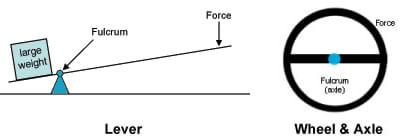
Although the type of lever in Figure 1 is the one most commonly referenced (fulcrum between force and resistance), there are two other types of levers. One, such as a bottle opener, has the fulcrum on one end of the bar and the resistance is between the fulcrum and the force. The second, such as a broom (see Figure 2), has the fulcrum on one end, and the force is between the resistance and the fulcrum.
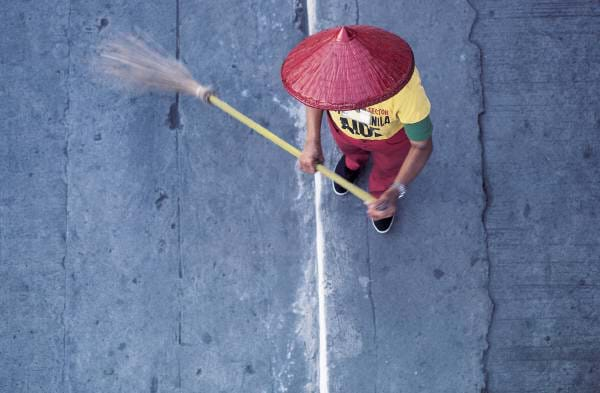
It is believed by many historians that ancient engineers used levers extensively to lift or hoist large blocks and stones into place. As the ancient Greek historian Herodotus wrote:
"After laying the stones for the base, they raised the remaining stones to their places by means of machines formed of short wooden planks. The first machine raised them from the ground to the top of the first step. On this there was another machine, which received the stone upon its arrival, and conveyed it to the second step, whence a third machine advanced it still higher." Source: World Mysteries, Mystic Places, Construction of the Great Pyramid: www.world-mysteries.com/mpl_2_1.htm#Machines
In this manner, ancient engineers were able to methodically iterate "hoists" that lifted the heavy stone with a relatively small force.
(Herodotus, the "father of history," [425-485 BC] is an ancient Greek historian whose accounts, chiefly concerning the wars between the Greeks and Persians, are the earliest known examples of narrative historical writing.)
Show students an excellent animation at a Polish website about transportation methods that do not use a wheel and axle: www.swbochnacki.com (click on Site Map, then click on Transport within Pyramid's Benches). The animation shows use of levers and inclined planes to move objects up the steps of a pyramid.
Mechanical Advantage
Simple machines provide an easier way to do work due to a tradeoff between force and distance. This is called mechanical advantage. A lever allows an object to be lifted by exerting minimal downward force.
Wheel and Axle
With the popularity of vehicles today, we can see that the wheel and axle are main components in a very effective mode of transportation. Refer to the open-ended design associated activity Wheeling It In! to challenge students to design their own wheel and axle carts. Whether transporting people on long road trips, hauling cement or gravel, or moving furniture, cars, dump trucks, moving trucks and buses are successful modes of transportation. In fact, virtually all methods of transportation use the wheel and axle in some way. Although these types of vehicles did not exist in the early days of pyramid building, the wheel and axle, a simple machine, did exist.
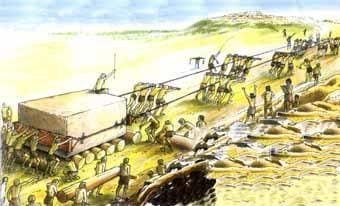
Many archeologists believe that Egyptian engineers transported stone blocks long distances by placing logs under the stones, with large numbers of people manually pulling on a rope attached to the front end of the stone, and continually adding new logs under the leading edge of the stone as the block was rolled forward (see Figure 3). This transportation method can be thought of as a simple wheel and axle, with the logs serving as rudimentary wheels. This method facilitated the transportation of stone that would otherwise have been much too heavy to move from a rock quarry to a construction site.
Other Transport Methods
Other stone transportation methods included two- to four-wheeled carts. The stone could have been hoisted onto the cart by the same method that is believed to have been used by the Egyptians. However, in the case of Mesoamerican pyramids, where the block size was not as huge, simpler levers could have been used.
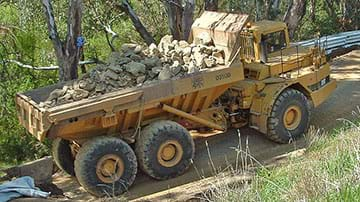
If we were to transport large blocks of stone today, we would probably use a dump truck (see Figure 4). Many present day construction materials are transported from a quarry to a foundation site using dump trucks. These trucks employ hydraulic cylinders that lift and tilt the truck bed to release its contents. The bed of the truck is essentially a lever; the fulcrum is created at the point at which the bed tilts. This transportation method demonstrates an effective combination of two simple machines — the wheel and axle, and the lever — to transport large and heavy loads. The wheel and axle allow for long distances to be traveled at a faster pace — providing a mechanical advantage. But, because a wheel is used, many revolutions are needed to travel this distance.
Engineering Design Process
As the students design and build their own version of an ancient transport system, consider introducing them to the engineering design process — a series of steps that engineering teams use to guide them as they solve problems.
- Ask: Identify the Needs and Constraints: What is the problem? What do I want to do? What are the project requirements? What are the limitations? Who is the customer? What is the goal?
- Research the Problem: Gather information and research what others have done. Talk to people from many different backgrounds and specialties to assist with researching what products or solutions already exist, or what technologies might be adaptable to your needs.
- Imagine: Develop Possible Solutions: You work with a team to brainstorm ideas and develop as many solutions as possible. This is the time to encourage wild ideas and defer judgment! Build on the ideas of others! Stay focused on topic, and have one conversation at a time! Remember: good design is all about teamwork!
- Plan: Select a Promising Idea: Revisit the needs, constraints and research from the earlier steps, compare your best ideas, select one solution and make a plan to move forward with it.
- Create: Build a Prototype: Building a prototype makes your ideas real! These early versions of the design solution help your team verify whether the design meets the original challenge objectives. Push yourself for creativity, imagination and excellence in design.
- Test and Evaluate Prototype: Does it work? Does it solve the need? Communicate the results and get feedback. Analyze and talk about what works, what doesn't and what could be improved.
- Improve: Redesign as Needed: Discuss how you could improve your solution. Make revisions. Draw new designs. Iterate your design to make your product the best it can be.
And now, REPEAT!
Engineers explore all possible options and compare many design ideas. This is called open-ended design because when you start to solve a problem, you don't know what the best solution will be. Engineers use prototypes, or early versions of the design to improve their understanding of the problem, identify missing requirements, evaluate design objectives and product features, and get feedback from others. Engineers select the solution that best uses the available resources and best meets the project's requirements.
Associated Activities
- Wheeling It In! - In an open-ended design activity, students use everyday materials to construct wheel and axle carts, and use a simple lever to load blocks of clay onto the carts. Students choose their materials and engineer solutions, designing small-scale transportation devices to convey ancient pyramid-building materials. Students race their carts/trucks, measure distance, time and weight, and calculate speed.
Lesson Closure
Let's discuss the pyramid building processes that may have been employed by engineers from ancient cultures. How might these processes have differed based on the kinds of pyramids they built or where they built them? (Answer: Different methods were used to move smaller rocks than larger rocks; used simple machines like the lever, and wheel and axle.)
How might a wheel and axle, a lever, or a combination of both, facilitate the transportation of materials? (Answer: These simple machines provide a mechanical advantage, which allows for the transportation of objects that would be otherwise too large or heavy for the average person to transport by hand. It also allows for faster and longer distance transportation.)
Conduct summary assessment activities as described in the Assessment section.
In other lessons of this unit, students study each simple machine in more detail and see how each could be used as a tool to build a pyramid or a modern building.
Vocabulary/Definitions
design: (verb) To plan out in systematic, often graphic form. To create for a particular purpose or effect. Design a building. (noun) A well thought-out plan.
distance: A measure of space between two objects.
engineering: Applying scientific and mathematical principles to practical ends such as the design, manufacture and operation of efficient and economical structures, machines, processes and systems.
force: A push or pull on an object.
fulcrum: The point at which a lever pivots.
lever: A simple machine that increases or decreases the force to lift something. Usually a bar pivoted on a fixed point (fulcrum) to which force is applied to do work.
mechanical advantage : An advantage gained by using simple machines to accomplish work with less effort. Making the task easier (which means it requires less force), but may require more time or room to work (more distance, rope, etc.). For example, applying a smaller force over a longer distance to achieve the same effect as applying a large force over a small distance. The ratio of the output force exerted by a machine to the input force applied to it.
mesoamerica: A region extending south and east from central Mexico to include parts of Guatemala, Belize, Honduras and Nicaragua. In pre-Columbian times it was inhabited by diverse civilizations, such as the Mayan and the Olmec.
quarry: A pit from which rock or stone is removed from the ground.
simple machine: A machine with few or no moving parts that is used to make work easier (provides a mechanical advantage). For example, a wedge, wheel and axle, lever, inclined plane, screw, or pulley.
speed: A measure of how fast an object is traveling.
transport: To carry from one place to another; to convey.
weight: A measure of how heavy or light something is. The weight of an object is the mass of the object times the force of gravity pulling on the object.
wheel and axle: A simple machine that reduces the friction of moving by rolling. A wheel is a disk designed to turn around an axle passed through the center of the wheel. An axle is a supporting cylinder on which a wheel or a set of wheels revolves.
wonder: Something that arouses awe, astonishment, surprise or admiration; a marvel.
work: Force on an object multiplied by the distance it moves. W = F x d (force multiplied by distance).
Assessment
Pre-Lesson Assessment
Brainstorming: As a class, have the students engage in open discussion to generate a number of possible ideas about transportation for pyramid design. Remind students that in brainstorming, no idea or suggestion is "silly." All ideas should be respectfully heard. Take an uncritical position, encourage wild ideas and discourage criticism of ideas. Have them raise their hands to respond. Write their ideas on the board. Encourage discussions that involve the use of any simple machines as you ask the students:
- How did ancient engineers build pyramids? What tools did they use?
Post-Introduction Assessment
Question/Answer: Ask the students and discuss as a class:
- For what reason do engineers use a combination of wheel and axle, and levers to transport materials today? (Answer: Using a wheel and axle, or lever system creates a mechanical advantage, making easier the transportation of materials that would otherwise be too large or heavy to transport.)
- Why is the wheel referred to as a type of lever? (Answer: A wheel is a lever that is able to rotate 360 degrees about its focal point [axle].)
- How might you use a wheel and axle, or lever, if you were constructing your own house? (Possible Answers: Use a dump truck to transport materials such as rock, sand and gravel. Use a flat-bed truck to transport materials such as beams, wood and appliances. Use a wheel barrow or dolly to move items around once off the truck.)
Lesson Summary Assessment
Engineering Report: Assign the students to write a short entry in their "ancient time capsule journal" that describes the relevance of the wheel and axle, and the lever in the building of pyramids, and addresses the following issues:
- How might Egyptian and Mesoamerican engineers have used the wheel and axle?
- How might Egyptian and Mesoamerican engineers have used the lever?
- Why was the use of these simple machines so important?
- Draw and label the parts of a wheel and axle.
- Draw and label the parts of a lever.
- List five items with which you are familiar that use either a wheel and axle, or a lever.
- Describe the steps of the engineering design process.
Pass the Buck: Engineering Design- In groups of four, have students brainstorm ideas to define an engineering design problem related to the above lesson (i.e. some sort of transportation problem). What is the need or want of your problem? First, assign one student in the group to be the recorder. Then, have someone toss out an idea. Next, another person in the group provides an idea that builds on the first. Go around the group in this fashion until all students have put in enough ideas to define an engineering design problem. Next, have students define a short list of criteria that the design must meet. For instance, the design must move lift the object 50 feet. Help the students understand what a design criteria is. Lastly, have students come up with a short list of constraints for their problem (e.g.. material constraints such as they only have materials that were available in ancient times; or they only have a budget of one hundred dollars). Help students understand the idea of engineering constraints (materials, time, costs, etc). When they are done, have them share their idea(s) with the class. Encourage the incorporation of any simple machines they have learned about. This can also be a fun exercise as an entire class- especially if students are new to the engineering design process!
Lesson Extension Activities
Take a "field trip" to the playground and have students draw and list objects containing a lever, or wheel and axle (or any other simple machines).
Ancient engineers had to transport large, heavy rock across water. Have students brainstorm ways in which they would transport pyramid stones across water.
Have students play the BBC's Pyramid Challenge online educational game at http://www.bbc.co.uk/history/ancient/egyptians/launch_gms_pyramid_builder.shtml.
Additional Multimedia Support
Show students a six-minute online video about a Michigan man who is building a Stonehenge replica to show people how its huge blocks could have been placed without modern heavy equipment. See "Building Stonehenge: This Man Can Move Anything" at: https://www.youtube.com/watch?v=lRRDzFROMx0
Subscribe
Get the inside scoop on all things TeachEngineering such as new site features, curriculum updates, video releases, and more by signing up for our newsletter!More Curriculum Like This

Students are introduced to the six types of simple machines — the wedge, wheel and axle, lever, inclined plane, screw, and pulley — in the context of the construction of a pyramid, gaining high-level insights into tools that have been used since ancient times and are still in use today.

In this open-ended design activity, students use everyday materials—milk cartons, water bottles, pencils, straws, candy—to build small-scale transportation devices. They incorporate the use of two simple machines—a wheel and axle, and a lever—into their designs.

Students are introduced to three of the six simple machines used by many engineers: lever, pulley, and wheel-and-axle. In general, engineers use the lever to magnify the force applied to an object, the pulley to lift heavy loads over a vertical path, and the wheel-and-axle to magnify the torque appl...

Students apply the mechanical advantages and problem-solving capabilities of six types of simple machines (wedge, wheel and axle, lever, inclined plane, screw, pulley) as they discuss modern structures in the spirit of the engineers and builders of the great pyramids.
References
Bochnacki, Andrzeh. 2005. O Piramidach Inaczeh. Andrzej Bochnacki (Polish engineer). www.swbochnacki.com. Accessed January 18, 2006. (An excellent animation shows use of levers to move objects up the steps of a pyramid, Click on Site Map, then click on Transport within Pyramid's Benches.)
Construction of the Great Pyramid, Construction Theories. www.World-Mysteries.com. Accessed January 18, 2006. (Includes translated quotations from the ancient Greek historian Herodotus, and an excellent animation of the method of raising pyramid stone blocks, as described by Herodotus.)
Dictionary.com. Lexico Publishing Group, LLC. www.dictionary.com. Accessed January 18, 2006. (Source of some vocabulary definitions, with some adaptation)
Dollinger, André, "An Introduction to the History and Culture of Pharaonic Egypt" and "Building in Stone: The Tools." André Dollinger, Reshafim, Israel. nefertiti.iwebland.com. Accessed January 18, 2006.
Dollinger, André, Building in Stone: The Tools, André Dollinger, Reshafim, Israel. Accessed January 18, 2006.
Loethen, Chris. Pyramids Schmeramids: Why the Pyramids of Egypt and Mesoamerica Do Not Share a Common Source. anth507.tripod.com. Accessed January 18, 2006.
Pyramid Challenge. BBC-History, British Broadcasting Corporation, London, UK. www.bbc.co.uk/history/ancient/egyptians. Accessed January 18, 2006.
Westbroek, Glen. Wheel and Axle. Updated August 7, 2000. Utah State Office of Education. www.usoe.k12.ut.us. (Excellent animation of wheel and axle) Accessed January 18, 2006.
Copyright
© 2005 by Regents of the University of Colorado.Contributors
Luz Quiñónez; Lawrence E. Carlson; Jacquelyn F. Sullivan; Malinda Schaefer Zarske; Glen Sirakavit; Denise W. Carlson, with conceptual input from the students in the spring 2005 K-12 Engineering Outreach Corps course.Supporting Program
Integrated Teaching and Learning Program, College of Engineering, University of Colorado BoulderAcknowledgements
The contents of these digital library curricula were developed by the Integrated Teaching and Learning Program under National Science Foundation GK-12 grant no. 0338326. However, these contents do not necessarily represent the policies of the National Science Foundation, and you should not assume endorsement by the federal government.
Last modified: October 30, 2020









User Comments & Tips